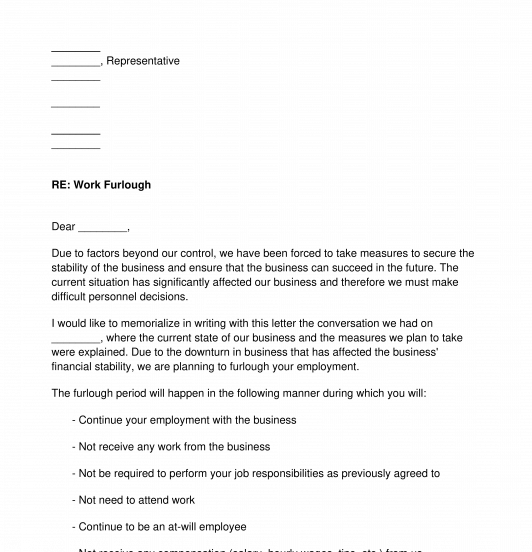 09/02/2025
09/02/2025

Answer a few questions and your document is created automatically.

Your document is ready! You will receive it in Word and PDF formats. You will be able to modify it.

 09/02/2025
09/02/2025
 Word and PDF
Word and PDF
 1 to 2 pages
1 to 2 pages



This Furlough Letter is a document used by an employer to inform an employee that they are being placed on furlough for some period of time. A furlough is a mandatory unpaid leave of absence. Though furloughed employees technically maintain their jobs, being placed on furlough means that they will no longer perform work for their employer and will not be paid a salary or other wages. This is a temporary arrangement, so once the furlough period ends, the employee is expected to return to work where their original job duties will resume and they will be paid by the employer once again.
Unfortunately, businesses sometimes struggle and business owners find themselves having increasing difficulty making payroll or staying operational while under such distress. Although permanent layoffs are one option for a business in distress, a more desirable option may be placing workers on furlough instead. Furloughs can be beneficial for both the employer and employee. For the employer, placing employees on temporary furlough makes it quicker and easier for them to resume business as usual when economic conditions improve. Rather than needing to hire a whole new workforce, they can just bring back their experienced and trained furloughed employees. For employees, although they will not receive wages during the furlough period, they generally retain their benefits, such as employer-sponsored health insurance, and often qualify for unemployment payments.
How to use this document
This letter has all of the information necessary for an employer to make a formal declaration to their employee that they will be placed on furlough. In addition to names and contact information for the employer and employee, the letter also specifies whether the employer and employee have already discussed the furlough. If they have already had a discussion about the situation, this letter can act as an important written record of that verbal notice. The letter also explains the reason for the furlough, whether it is due to a downturn in business, temporary closure of the business, or some other reason. The employer can specify when the furlough will start and, if known, end, and the arrangements that will take place during the furlough period. Finally, depending on the state where the business operates, the employer can indicate whether there is a non-compete clause in the original employment agreement by which the employee must abide. This means that the employee will be barred from conducting business that is too similar in nature and in too close a geographic location to the employer, even during this furlough period.
Once the letter is completed, the employer should send a copy to the employee via certified mail. This way, the employer will have a receipt showing that the employee received the letter in case of a future dispute. Both the employer and employee should save written copies of this letter. Written documentation is both helpful in case the employer and employee later disagree about the terms of the furlough. Documentation can also be helpful for employees who are applying for unemployment payments or seeking other forms of relief and need proof of their changed employment status.
Applicable law
Decisions related to furlough, lay-offs, employment, and employment agreements in the United States are subject to both federal laws and specific state laws. For example, the federal Fair Labor Standards Act (FLSA) covers wages and overtime pay for certain sectors. State laws, however, may define and restrict how employers can protect themselves if an employee tries to take their clients or use confidential information.
How to modify the template
You fill out a form. The document is created before your eyes as you respond to the questions.
At the end, you receive it in Word and PDF formats. You can modify it and reuse it.
A guide to help you: How to Send a Letter
Furlough Letter - FREE - Template - Word & PDF
Country: United States